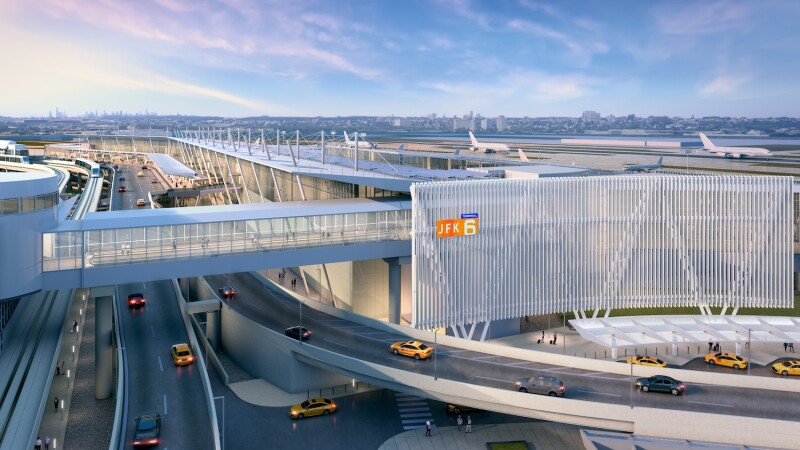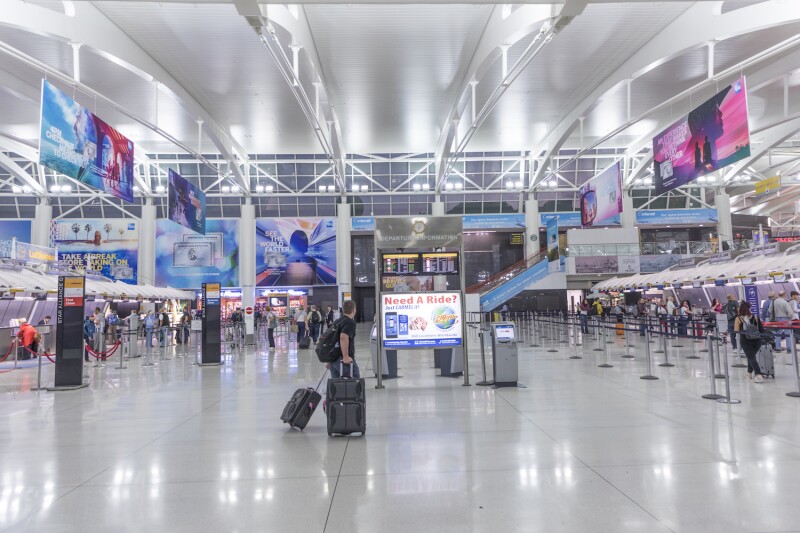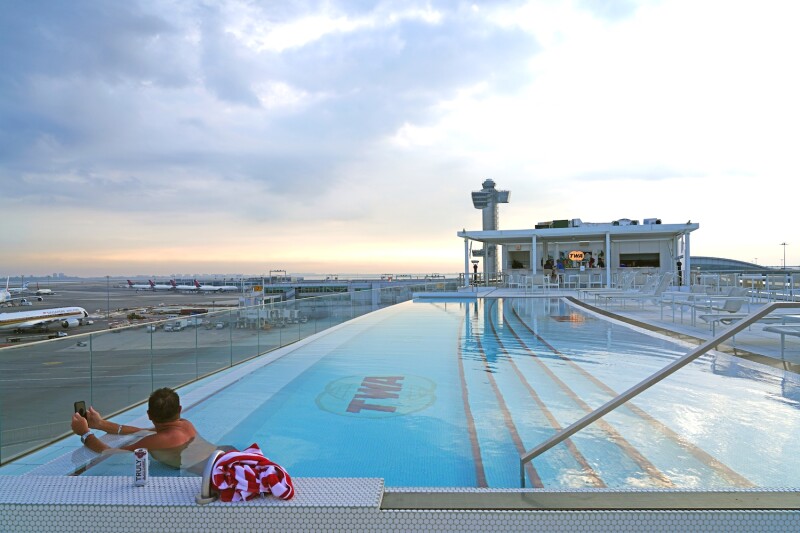Like its hometown, New York’s John F. Kennedy International Airport—commonly referred to by its airport code JFK—is perpetually in a state of transition. The hub is still feeling some of the lingering effects of the pandemic, but many of the businesses and services that were suspended during the pandemic are back in action (though don’t be surprised if an eatery you remember frequenting prior to the pandemic is—sadly—gone for good).
A new JFK is on the way

A rendering of the forthcoming new Terminal 1.
Courtesy of the Port Authority of New York and New Jersey
JFK has indeed experienced many changes over the years, but perhaps one of the biggest is yet to come. The airport is poised for a total overhaul and is due to be ripped up and redesigned under a bold plan to create a new terminal complex that aims to bring the airfield fully into the 21st century. The ambitious and costly project—the total tab will likely exceed $14 billion—calls for the demolition of existing terminals 2 and 7 (occupied by Delta and British Airways, respectively) and construction of two sweeping complexes, each anchored by a group of major airline tenants.
At the south side of JFK will be the New Terminal 1 for major tenants Air France, Lufthansa, JAL, and Korean, which will be connected to an expanded Terminal 4, home to Delta and dozens of other foreign carriers.
At the other end of the airfield, JetBlue will add to its current Terminal 5 base a new Terminal 6, putting it next door to its partner, American, whose expanded digs will soon accommodate British Airways and its bespoke lounges.

A rendering of JetBlue’s plans for a new Terminal 6.
Courtesy of the Port Authority of New York and New Jersey
As ambitious and exciting as the reimagined JFK is, that plan is still unfortunately years away. Some new facilities will open in 2025 but the makeover won’t be fully completed until 2030. For now, the airport consists of a (sometimes confusing) set of six terminals, numbered 1 through 8—terminals 3 and 6, built by Pan Am and National Airlines, respectively, were demolished a decade ago.
JFK, from past to present

The former TWA Flight Center has been reborn as the TWA Hotel.
Photo by Shutterstock
JFK first opened in 1948 as “Idlewild,” after the defunct golf course that was bulldozed to make way for what was at the time the largest international airport in world. By the 1960s, the airfield—by then rechristened after the late president—was a jet-set magnet, with VIPs from the Beatles to Liz Taylor keeping the local paparazzi busy, so much so there was even a full-time press room right at the airport. Although in size it’s been surpassed by behemoth hubs like Beijing and Dubai, it’s served by 70 international and domestic airlines and is still regarded as a leading gateway for globe-trotters.
One of the airport’s most impressive design features is the landmark Eero Saarinen–designed TWA Flight Center, which was salvaged and is now part of a hotel complex connected to JetBlue’s Terminal 5. Fully restored, the TWA Hotel is a nostalgia-filled shrine to Sixties-era glamour—and one of the better reasons for including this airport in your travel plans.
JFK is undoubtedly a constantly shifting, crazy quilt of separate terminals—each with its own unique venues and vibe. Despite the challenges of navigating the complex, there is plenty to appreciate and enjoy while waiting for your flight, especially if you plan ahead. Here’s our complete guide to how to best conquer this bustling New York hub.
How to get there

There are several public transit options for getting to JFK.
Photo by Shutterstock
JFK isn’t as far from Manhattan as many people think. It’s about 16 miles from the airport to Times Square. But because it lacks a direct connection of a “one-seat ride” on public transportation like London’s convenient Heathrow Express, it can take anywhere from one to two hours to get there from the city by road or rail—unless you take a helicopter, which can whisk you there in five minutes for around $200.
By rail
The fastest rail connection is via the Long Island Railroad from Penn Station on Manhattan’s west side to the Jamaica, Queens, station, where you can transfer to the JFK Air Train, a light-rail system that stops at every terminal; the cost is $15 for the rail ticket plus $7.75 for the airport link. Total travel time: just under one hour.
The other option is to take the New York City subway to the stations closest to the airport, at Jamaica and Howard Beach, where you can pick up the Air Train. That will save you $5 but add significantly to travel time because of all the local stops. Depending on where you start, this can take anywhere from 40 minutes to well over an hour.
By road
Cabs and rideshares to JFK vary in cost, but as a benchmark, the city mandates a flat rate of $52, plus tip and tolls, on yellow cab fares between Manhattan and JFK; for other city neighborhoods, the metered fare applies.
Rideshares via Uber, Lyft, and smaller rivals can be a bit less pricey in off-hours but also are subject to peak pricing surcharges, which can push the tab to over $100. If you’re driving your own car, there are plenty of spots in long-term parking lots with a maximum fee of $20 a day versus up to $42 a day to park in short-term lots closer to the terminals. You can check how full the lots are before leaving home, or plan ahead and prebook parking online. All on-airport parking lots, including long-term, are connected to terminals via the free JFK AirTrain.
There are service kiosks in the arrivals area of each terminal where you can also arrange for bus or van trips. Airlink and ETS Air Shuttle are two of the main van services authorized to operate on-site. Fares start at $20 one-way between JFK and the Grand Central train station in midtown Manhattan.
Pro tip: If you’re going by road, try to time your departure to avoid the worst of the rush hour traffic—typically from 6 a.m. to 9 a.m. and from 4 p.m. to 7 p.m. on weekdays.
Health and wellness at JFK
Travel can be stressful, and the pandemic didn’t help.
For those who need COVID testing services, testing centers on-site are available by appointment and for walk-ins depending on availability located at terminals 1, 4, and 5. One of these providers, XpresCheck, offers both PCR and rapid antigen tests at the arrivals level at Terminal 4.
The same company has just opened its first airport health and wellness clinic, named Treat, at Terminal 4, staffed by medical professionals. In addition to COVID testing, the location also offers services like flu shots and IV drip infusion therapy, as well as private rooms for yoga or meditation sessions.
The outfit is probably better known to travelers for the massages and manicures it offers to weary travelers at locations of its XpresSpa airport chain. And thankfully, those locations have started to open back up (after being put on pause during the pandemic), including in Terminal 4 at JFK.
But if you’ve got a longer layover and want to find a place to work out or just relax, head for the TWA Hotel, which has a rooftop swimming pool with runway views and a gym. You can gain access to those amenities if you book a day room—and the pool is now open to nonguests for a fee of $25 per adult (and $20 per child) Monday through Thursday and for $50 per adult on weekends ($20 per child on weekends). In another offbeat attraction, the hotel has an outdoor roller skating rink, open on Fridays through Sundays from April 15 to November 1. The cost is $20 for adults and $16 for children for a 50-minute session.
The best places to eat, shop, and relax in each JFK terminal

Terminal 1 is among JFK’s main international terminals.
Photo by Shutterstock
Terminal 1
The main airline tenants in Terminal 1 are Air France, Japan Airlines, Korean, Lufthansa, and Turkish. So, it’s not surprising the duty-free shopping is first rate, with brands like Bulgari and Cartier on offer.
If you can gain access, the T1 airline lounges provide a posh place to escape for business- or first-class passengers. Otherwise, there’s also a Primeclass lounge for Priority Pass members, which also offers free food and drink and a quiet space away from the crowds.
Where to eat in Terminal 1
The dining is mostly fast food but here are some reliable options:
- Starbucks: for your caffeine fix
- The Local: serving American standards like burgers and pizza
- Martini Bar: perfect for a preflight cocktail
Terminal 2
Delta is the only airline operating here and given that the airline is slated to move all of its operations to the larger Terminal 4 next door in mid-2023, the amenities here are modest—a few fast food venues, a Starbucks, and convenience stores. At least there is a Delta Sky Club.

Terminal 4 is currently Delta’s main hub at JFK.
Photo by Shutterstock
Terminal 4
The former utilitarian International Arrivals Building was gutted and fully renovated in the early aughts, replaced by the vast and airy Terminal 4 space, which boasts dozens of high-end shops and restaurants, lounges, and even a valuable private art collection. International airlines ranging from Air India to Emirates and Virgin Atlantic operate from this terminal alongside Delta, which flies both domestic and foreign flights from here.
Where to eat in Terminal 4
- Shake Shack: a cult, fast-casual burger, fries, and shake chain
- The Palm Bar & Grille: serving hearty steakhouse fare
- Le Grand Comptoir: a wine bar that serves cheese and charcuterie
Terminal 5
JetBlue’s home base, Terminal 5, is one of the newer terminals at the airport and that’s evident in the abundance of shopping and dining choices. For shopping, choices include Ron Jon Surf Shop (a purveyor of swimwear and resort apparel), sports souvenirs at WFAN 66, and two bookstores—Heritage Books and WhereTraveler.
Where to eat in Terminal 5
The above-average food court in the airy central plaza is a great option for quick to-go grub. The terminal also houses several sit-down restaurants, including:
- 5ivesteak: for steaks, burgers, and sandwiches. It opens at 5 a.m. for a full breakfast and serves both lunch and dinner.
- Deep Blue Sushi: a popular choice for Japanese food
- AeroNuova: good for Italian pastas and meatball sandwiches

Deep Blue Sushi is a solid option for Japanese fare in JetBlue’s Terminal 5 at JFK.
Photo by Shutterstock
Terminal 7
The first JFK terminal to be anchored by a foreign airline, British Airways, Terminal 7 is also home to Iberia, Alaska, and United. Lounges here include BA’s first-class Concorde room with a champagne bar plus a business-class lounge. There’s also Alaska’s stylish refuge with food and beverage offerings inspired by its Pacific Northwest roots. The rest of the terminal’s food choices are decidedly less inspiring, with a Dunkin’ and a burger joint for those seeking a preflight bite.
Terminal 8
American Airlines and Oneworld partners like Finnair are the main tenants here. American Airlines’ Flagship Lounge and Admirals Club are available for club members and premium passengers.
Where to eat in Terminal 8
For a quick breakfast, there’s Dunkin’; for grab-and-go lunch or dinner, there’s pizza. Otherwise, head to Bobby Van’s, a New York–style wood-paneled steakhouse that also offers a wide array of sandwiches and salads and the best sit-down dining option in the terminal.
The best way to spend a layover at JFK

Time to spare? Head to the TWA Hotel to explore some historical exhibits.
Photo by Shutterstock
- Check out the art. You don’t have to go beyond security to see works like Alexander Calder’s massive Flight mobile at Terminal 4. Beyond security, there are rotating displays of art throughout the terminals. Indeed, JFK has more than a few interesting art pieces—if you have time to slow down and look. At the TWA Hotel, exhibits to explore include an homage to Eero Saarinen, the famed architect who designed the structure, as well as a collection of vintage TWA posters by noted artist David Klein.
- Have a meal at one of the TWA Hotel’s full-service restaurants. Options include the Paris Café by Jean-Georges, with cuisine inspired by 1960s’ inflight menus, curated by celebrity chef Jean-Georges Vongerichten, or the more casual Food Hall (with everything from bagels to tacos); both are good places to sit and enjoy a delicious meal. Or get cocktails at one of the scarlet-hued banquettes in the Sunken Lounge or in the vintage Lockheed Constellation (or “Connie”) propeller plane parked outside the hotel, which is now the watering hole for aviation enthusiasts.
- Explore locally. If you don’t have a long enough layover to go into Manhattan (you need at least 6 to 8 hours to make it worthwhile), there are several good waterfront restaurants about five miles away from the airport, including the Bayhouse, and Vetro Restaurant and Lounge. Both offer outdoor dining and Italian and seafood specialties.
The best airport lounges at JFK
- Air France and Lufthansa’s multi-level clubs in Terminal 1 offer sumptuous buffets, showers, and spas.
- Delta’s SkyClub at Terminal 4 has a large outdoor deck, with close-up views of the action on the runway. The same terminal also offers the Virgin Clubhouse and Emirates and Etihad’s gleaming clubs with full bars, buffets, sit-down dining, and showers.
- The British Airways and American lounges (in terminals 7 and 8, respectively) offer the usual upscale perks plus kids’ play spaces; BA’s three clubs include the fabled Concorde Room for its first-class fliers, with vintage champagne, fine wines, and other luxe touches that hark back to the heyday of its supersonic namesake.
The best places to work
Like most airports these days, there is fast and free Wi-Fi and stations for charging devices throughout the terminals. If you’re looking for a quiet corner to set up shop before your flight, but aren’t flying first or business, look into day passes for a lounge in your terminal. The Wingtips lounge in Terminal 4 and the Priority Pass digs in Terminal 1 offer reasonably priced memberships (starting at $75 and $99 per year, respectively) that will get you into their own branded lounges for a nice space to log in.
Few airlines sell day passes, but if you’re flying on Alaska Airlines out of Terminal 7, for $60 you can gain entry to its well-appointed lounge for the day.
Family fun
In addition to the play spaces in the British Airways and American lounges mentioned above, there is an aviation-themed interactive play area where kids can play imaginary pilot in JetBlue’s Terminal 5, near Gate 26. From other terminals, parents who are desperate to pass the time and entertain the kiddos can head to the TWA Hotel, which features a Twister Room, a larger-than-life version of the classic 1960s game, among other diversions. And there is always the free AirTrain, on which families can ride around the airport observing all the airplanes and people coming and going.
Plane spotting

There are a few prime runway viewing spots at JFK, including the rooftop pool at the TWA Hotel.
Photo by Shutterstock
Those who love watching planes take off and land can go to the observation deck at Terminal 5 (if they are flying JetBlue), where the deck doubles as a pet relief area (known as the “Wooftop”). Or head to the adjacent TWA Hotel, which has a rooftop pool (now open to nonguests for $20–$25 per adult, $20 per child) with views of the runway. Delta’s Sky Deck at Terminal 4 also offers close-up views of takeoffs and landings.
Where to stay at JFK
The TWA Hotel is the only place to stay right at the airport, and while it may be on the pricey side for an airport hotel (rates start at $279 a night), the incredible midcentury design more than compensates. (For a splurge, book a room with a runway view.)
There are some decent airport hotels within a few miles of the terminals, including a Crowne Plaza and the Radisson Hotel.








